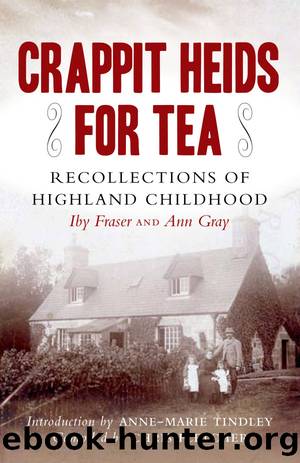Crappit Heids for Tea by Iby Fraser Ann Gray

Author:Iby Fraser, Ann Gray [Iby Fraser, Ann Gray]
Language: eng
Format: epub
Tags: Biography & Autobiography, Cultural; Ethnic & Regional, General, Historical, Personal Memoirs, Women, History, Europe, Great Britain, Scotland, Modern, 20th Century
ISBN: 9780857905369
Google: UiclEAAAQBAJ
Publisher: Casemate Publishers
Published: 2012-08-15T05:39:07+00:00
Farming
The smell of a nice, clean byre and of the opened-up chest or 'girnel',44 where the horses' corn was kept, were ones I liked. Meadow hay also gave off a pleasant odour, but it was difficult to harvest. It grew without a man's aid, just naturally, by the side of the loch â airy-fairy stuff that had to be tossed for days until it dried; much more difficult than the harvesting of clover hay grown on the farms.
A scythe was used to cut it, as the soft ground where meadow hay grew was not suitable for using a horse mower. On crofts, or farms, 'roads' were first cut round the fields with a scythe before the mowers got to work, drawn by horses. On little plots the women used sickles or 'heuks' â and these they used to cut nettles too, just as they did in Old Testament days.
Reapers were used on the farms to cut the corn and the sheaves were bound by hand â that is, until the wonderful binder came along. But still the sheaves had to be set up on end in stooks by following workers. The next process was building the dried stooks into 'ackers' or 'screws' before they were eventually carted to the farm square and made into stacks. Carts had special frames attached to their sides for 'leading' home the sheaves and when the stacking was finished, rushes, or 'rashes', as we called them, were carefully placed on top of each stack as a thatch to keep out the rain. Then ropes were criss-crossed over each finished stack to secure the thatch. A little 'toorie'45 of straw completed the edifice.
A full stack-yard gladdened the heart of every farmer and carefully fashioned stacks were something of which to be proud. A badly made one stuck out like a sore thumb â a rebuke to the builder.
Carts had their owners' names printed on a plaque at one side, and once, in Aberdeenshire, a teacher taking a religious education lesson asked the children how Joseph knew his brethren when they came to Egypt for corn. 'Please, Miss,' said a little boy. 'They'd have their names on their carts!' A true son of the soil was he.
When corn had to be threshed, the farm workers or crofter dismantled the stacks with a dog or two at hand to deal with the rats and mice that found refuge there during cold weather.
My aunt used to catch mice by balancing a bowl on a little stick above some oatmeal spread on a biscuit tin lid. The mouse touched the stick, down fell the bowl and it was imprisoned until my aunt came with a cat. And that was that!
My uncle used a flail to thresh corn sometimes. This was made of a short, rounded stick and a longer one, rather like broom handles, joined by a leather thong. He placed the sheaf on a wooden threshing floor, raised a few inches above the cement floor of the barn, and walloped the heads of grain, the long stick whirling over his shoulder rhythmically.
Download
This site does not store any files on its server. We only index and link to content provided by other sites. Please contact the content providers to delete copyright contents if any and email us, we'll remove relevant links or contents immediately.
Room 212 by Kate Stewart(4156)
The Crown by Robert Lacey(4143)
Endurance: Shackleton's Incredible Voyage by Alfred Lansing(3894)
The Iron Duke by The Iron Duke(3680)
The Rape of Nanking by Iris Chang(3569)
Killing England by Bill O'Reilly(3491)
Joan of Arc by Mary Gordon(3303)
Say Nothing by Patrick Radden Keefe(3108)
I'll Give You the Sun by Jandy Nelson(2872)
Shadow of Night by Deborah Harkness(2787)
Hitler's Monsters by Eric Kurlander(2770)
Margaret Thatcher: The Autobiography by Thatcher Margaret(2710)
Mary, Queen of Scots, and the Murder of Lord Darnley by Alison Weir(2700)
Darkest Hour by Anthony McCarten(2680)
Blood and Sand by Alex Von Tunzelmann(2636)
Red Famine: Stalin's War on Ukraine by Anne Applebaum(2498)
Eleanor & Park by Rainbow Rowell(2432)
The One Memory of Flora Banks by Emily Barr(2382)
Book of Life by Deborah Harkness(2311)
